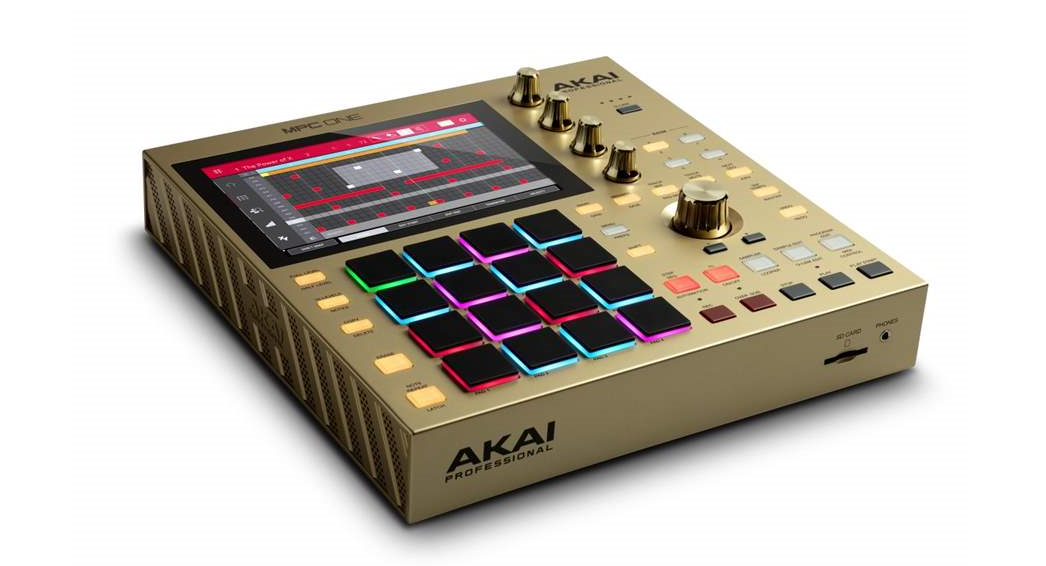
MPC ONEQuickstart Guide
Introduction
Features:
- Standalone MPC—no computer required
- 7” (177 mm) full-color multi-touch display
- Also acts as a control surface for MPC software
- Full-size MIDI input and output
- 2 GB of user storage, 2 GB pre-installed content included
- 2 GB of RAM
- Full-size SD card slot
- USB-A 2.0 slot for thumb drive or MIDI controller
Box Contents
MPC One – Software Download CardPower Adapter – Quickstart GuideUSB Cable – Safety & Warranty ManualImportant: Visit akaipro.com and find the webpage for MPC One to download the complete User Guide.
SupportFor the latest information about this product (documentation, technical specifications, system requirements, compatibility information, etc.) and product registration, visit akaipro.com. For additional product support, visit akaipro.com/support.
Connection DiagramItems not listed under Introduction > Box Contents are sold separately.
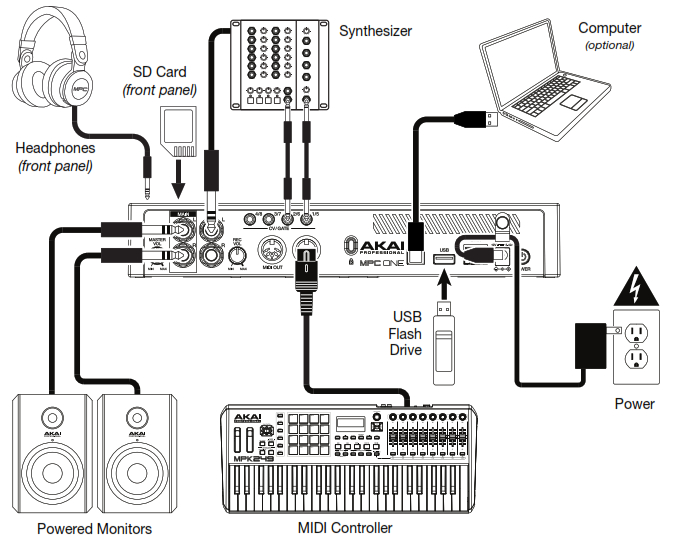
Features
Top Panel
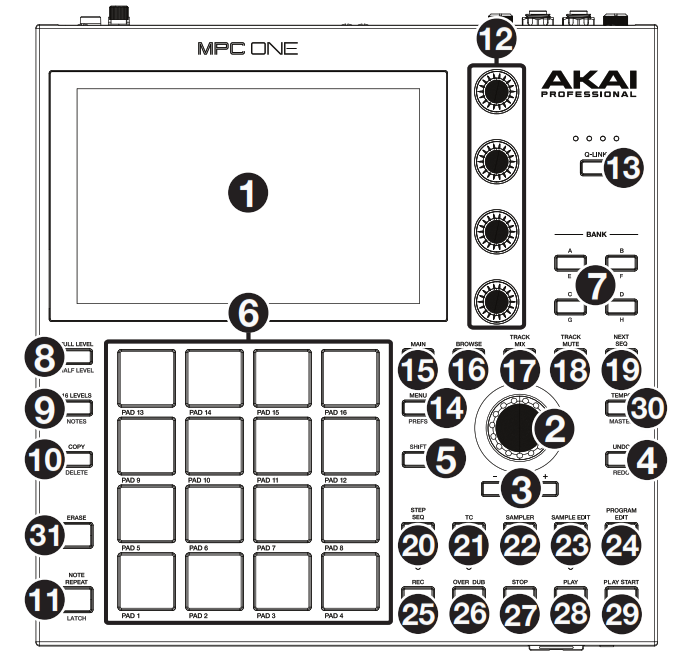
Navigation & Data Entry Controls1. Display: This full-color multi-touch display shows information relevant to MPC One’s current operation. Touch the display (and use the hardware controls) to control the MPC interface. See Operation to learn how to use some basic functions.Important: Remember to remove the protective film from the MPC One touchscreen!2. Data Dial: Use this dial to scroll through the available menu options or adjust the parameter values of the selected field in the display. Pressing the dial also functions as an Enter button.3. –/+: Press these buttons to increase or decrease the value of the selected field in the display.4. Undo / Redo: Press this button to undo your last action. Press and hold Shift and press this button to redo the last action you undid.5. Shift: Press and hold this button to access some buttons’ secondary functions (indicated by red writing).
Pad & Q-Link Controls6. Pads: Use these pads to trigger drum hits or other samples. The pads are velocity-sensitive and pressure-sensitive, which makes them very responsive and intuitive to play. The pads will light up different colors, depending on how hard you play them (ranging from yellow at a low velocity to red at the highest velocity). You can also customize their colors.7. Pad Bank Buttons: Press any of these buttons to access Pad Banks A–D. Press and hold Shift while pressing any of these buttons to access Pad Banks E–H. Alternatively, double-press one of these buttons.8. Full Level / Half Level: Press this button to activate/deactivate Full Level. When activated, the pads will always trigger their samples at the maximum velocity (127), regardless of the amount of MPC One you use. Press and hold Shift and then press this button to activate/deactivate Half Level. When activated, the pads will always trigger their samples at half-velocity (64).9. 16 Level / Notes: Press this button to activate/deactivate 16 Level. When activated, the last pad that was hit will be temporarily copied to all 16 pads. The pads will play the same sample as the original pad, but a selectable parameter will increase in value with each pad number, regardless of the amount of MPC One you use. Press and hold Shift and press this button to activate/deactivate Notes mode for the pads. When activated, you can play musical scales/modes, chords or progressions using the pads while in any mode. Use Pad Perform Mode to configure the settings for the pads.10. Copy / Delete: Press this button to copy one pad to another. When the From Pad field is selected, press the “source” pad (the pad you want to copy). When the To Pad graphic (of all pads) is selected, press the “destination” pad. You can select multiple destination pads, and you can select pads in different pad banks. Tap Do It to continue or Cancel to return to the previous screen. Press and hold Shift and press this button to delete.11. Note Repeat / Latch: Press and hold this button, and then press a pad to trigger that pad’s sample repeatedly. The rate is based on the current tempo and Time Correct settings. Press and hold Shift and then press this button to “latch” the Note Repeat feature. When latched, you do not have to hold the Note Repeat button for it to be activated. Press Note Repeat once more to unlatch it.12. Q-Link Knobs: Use these touch-sensitive knobs to adjust various parameters and settings. The knobs can control one column of parameters at a time. The lights above the Q-Link Knobs indicate the currently selected column. Press the Q-Link button to change which column of parameters they currently control.13. Q-Link Button: Press this button to change which column of parameters the Q-Link Knobs currently control (indicated by the lights above the Q-Link Knobs). Each press will select the next column. Press and hold Shift and then press this button to select the previous column instead.
Mode & View Controls14. Menu / Prefs: Press this button to open the Mode Menu. You can tap an option on the Menu screen to enter that mode, view, etc. Press and hold Shift and then press this button to open the Preferences page in the Menu.15. Main / Grid: Press this button to enter Main Mode. Press and hold Shift and then press this button to enter Grid View Mode.16. Browse / Save: Press this button to view the Browser. You can use the Browser to locate and select programs, samples, sequences, etc. Press and hold Shift and then press this button to save the current project (including its samples, programs, sequences, and songs).17. Track Mix / Pad Mix: Press this button to view the Track Mixer where you can set levels, stereo panning, and other settings for your tracks, programs, returns, sub-mixes, and masters. Press and hold Shift and then press this button to view the Pad Mixer where you can set a program’s levels, stereo panning, routing, and effects.18. Track Mute / Pad Mute: Press this button to view Track Mute Mode where you can easily mute tracks within a sequence or set mute groups for each track. Press and hold Shift and press this button to view Pad Mute Mode where you can easily mute pads within a program or set mute groups for each pad within a program.19. Next Seq / XYFX: Press this button to view Next Sequence Mode where you can trigger different sequences simply by playing the pads. This is useful for live performances, letting you change a song’s structure in real-time. Press and hold Shift and press this button to view XYFX Mode, which turns the touchscreen into an XY pad where each axis represents the range of an effect parameter. As you move touch or move your finger on the touchscreen, the current position will determine the current value of the two parameters. You can use this mode to create interesting effect automation on your tracks.20. Step Seq / Automation: Press this button to view Step Sequencer Mode where you can create or edit sequences by using the pads as “step buttons,” simulating the experience of a traditional step-sequencer-style drum machine. Press and hold Shift and press this button to open Grid View Mode with the last used automation parameter for the track selected.21. TC / On/Off: Press this button to open the Timing Correct window, which contains various settings to help quantize the events in your sequence. Press and hold Shift and press this button to turn Timing Correct on and off.22. Sampler / Looper: Press this button to view the Sampler where you can record audio samples to use in your projects. Press and hold Shift and press this button to view the Looper where you can record and overdub audio in real time—a great tool for live performance as well as spontaneous moments in the studio. You can export the loop as a sample to use in your project.23. Sample Edit / Q-Link Edit: Press this button to view Sample Edit Mode where you can edit your samples using various functions and processes. Press and hold Shift and press this button to view Q-Link Edit Mode where you can assign other parameters to the Q-Link knobs.24. Program Edit / MIDI Control: Press this button to view Program Edit Mode, which contains all parameters for editing your programs. Press and hold Shift and press this button to view MIDI Control Mode where you can customize what MIDI messages are sent from certain controls on your hardware.Transport & Recording Controls25. Rec: Press this button to record-arm the sequence. Press Play or Play-Start to start recording. Recording in this way (as opposed to using Overdub) erases the events of the current sequence. After the sequence plays through once while recording, Overdub will be enabled.26. Overdub: Press this button to enable Overdub. When enabled, you can record events in a Sequence without overwriting any previously recorded events. You can enable Overdub before or during recording.27. Stop: Press this button to stop playback. You can double-press this button to silence audio that is still sounding once a note stops playing. Press and hold Shift and press this button to return the play head to 1:1:0.28. Play: Press this button to play the sequence from the play head’s current position.29. Play Start: Press this button to play the sequence from its start point.30. Tap Tempo / Master: Press this button in time with the desired tempo to enter a new tempo (in BPM). Press and hold Shift and press this button to set whether the currently selected sequence follows its own tempo (the button will be lit amber) or a master tempo (the button will be lit red).31. Erase: As a Sequence is playing, press and hold this button and then press a pad to delete the note event for that pad at the current playback position. This is a quick way to delete note events from your sequence without having to stop playback. When playback is stopped, press this button to open the Erase window where notes, automation, and other sequence data can be erased from the sequence. Download the full User Guide for more information.
Front Panel
1. SD Card Slot: Insert a standard SD, SDHC or SDXC card into this slot to access its files directly using MPC One.2. Phones (1/8” / 3.5 mm): Connect standard 1/8” (3.5 mm) stereo headphones to this output.

Rear Panel

1. Power Input: Use the included power adapter to connect MPC One to a power outlet.2. Power Adapter Restraint: Secure the power adapter cable to this restraint to prevent it from accidentally unplugging.3. Power Switch: Turns MPC One’s power on/off.4. Link: Connect a standard Ethernet cable to this port to use Ableton Link and other compatible devices with MPC One. Download the full User Guide for more information.5. USB-B Port: Use the included USB cable to connect this high-retention-MPC One USB port to an available USB port on your computer. This connection allows MPC One to send/receive MIDI and audio data to/from the MPC software on your computer.6. USB-A Port: Connect a USB flash drive to this USB port to access files directly using MPC One. You can also connect a standard MIDI controller to this port.7. Rec Vol: Turn this knob to adjust the volume of the inputs.8. Inputs (1/4” / 6.35 mm): Use standard 1/4” (6.35 mm) TRS cables to connect these inputs to an audio source (mixer, synthesizer, drum machine, etc.). In Sample Record Mode, you can select whether you want to record either channel or both channels in stereo or in mono.9. Master Vol: Turn this knob to adjust the volume of the outputs and phones output.10. Outputs (1/4” / 6.35 mm): Use standard 1/4” (6.35 mm) TRS cables to connect these outputs to your monitors, mixer, etc.11. MIDI In: Use a standard 5-pin MIDI cable to connect this input to the MIDI output of an external MIDI device (synthesizer, drum machine, etc.).12. MIDI Out: Use a standard 5-pin MIDI cable to connect this output to the MIDI input of an external MIDI device (synthesizer, drum machine, etc.).13. CV/Gate Outs: MPC One will send control voltage (CV) and/or Gate signals over these outputs to optional external sequencers. Use standard 1/8” (3.5 mm) TS cables to send a single CV/Gate signal per output, or use a stereo TRS-to-dual mono TSF breakout cable (such as a Hosa YMM261) to send two CV/Gate signals per output.14. Kensington ® Lock Slot: You can use this slot to secure your MPC One to a table or other surface.
Operation
Here is some general information about how to use the MPC One display:
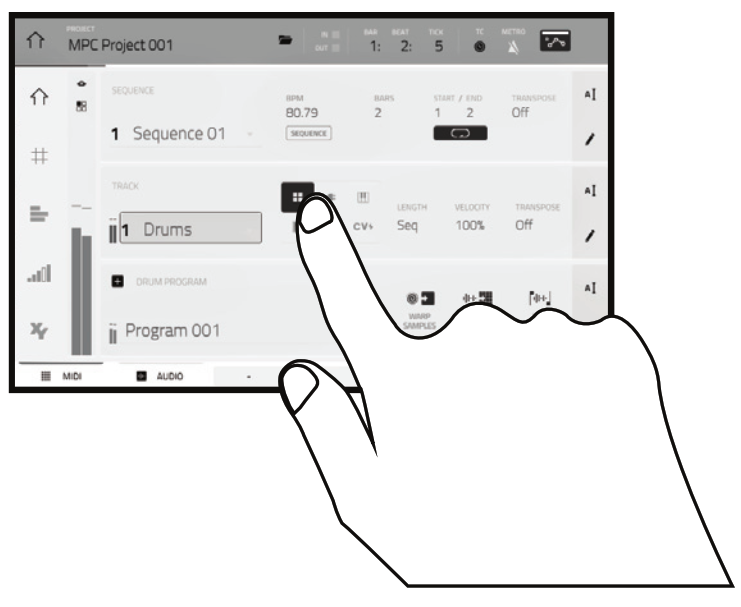
Tap a button or option to select it. Use the data dial or –/+ buttons to change its setting or value
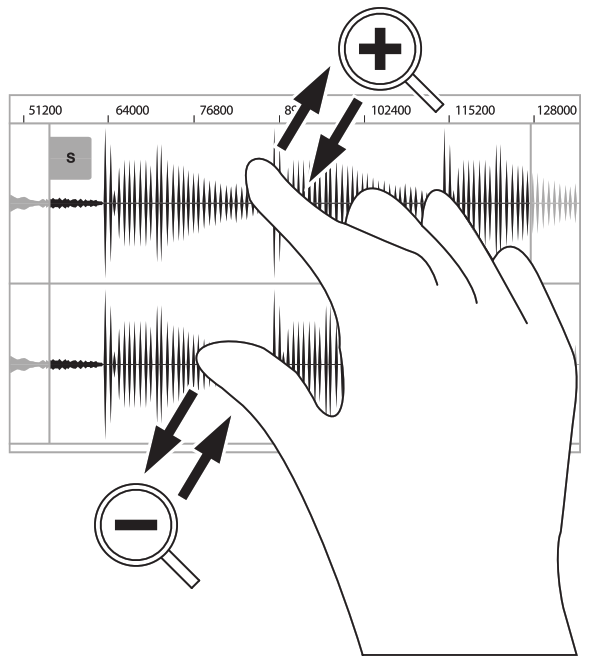
Spread two fingers to zoom in (into a section of a waveform, for example). Pinch two fingers to zoom out.
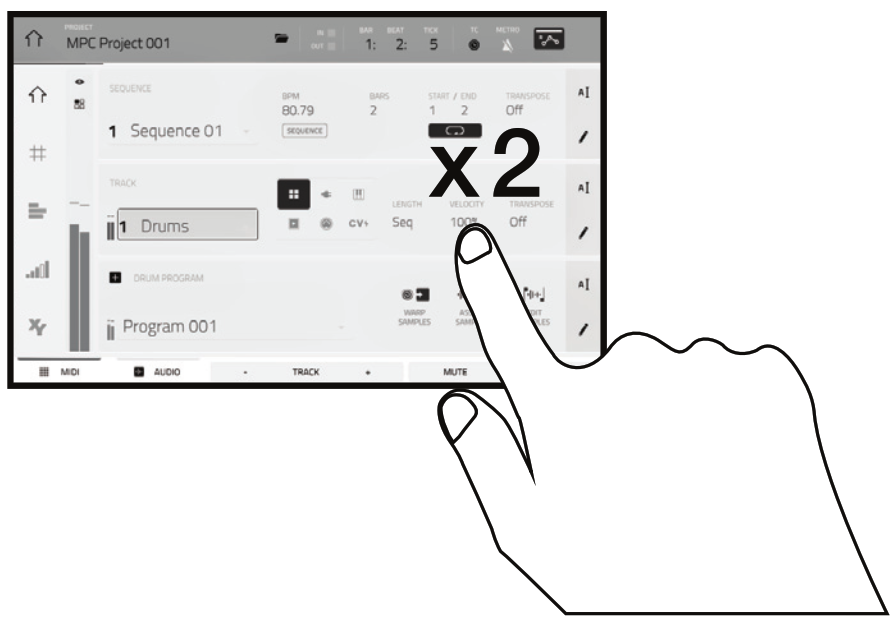
Double-tap a button to access advanced editing options. In some cases, this will show a numeric keypad that you can use to enter a value (an alternative to the data dial or –/+ buttons). Tap the upper-left part of the display to return to the previous view. The upper edge of the display shows the toolbar, which contains information about the current view (often the name of the current track, sequence, audio pointer position, etc.). Tap an item to select it. The lower edge of the display shows various buttons that you can use in the current view. Tap a button to press it. To return to a previous view, either tap outside of the window currently in the display or tap the left arrow (
The upper edge of the display shows the toolbar, which contains information about the current view (often the name of the current track, sequence, audio pointer position, etc.). Tap an item to select it. The lower edge of the display shows various buttons that you can use in the current view. Tap a button to press it. To return to a previous view, either tap outside of the window currently in the display or tap the left arrow (![]() ) in the upper-left part of the display.
) in the upper-left part of the display.
References
[xyz-ips snippet=”download-snippet”]

